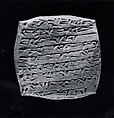Cuneiform tablet: quittance for a loan in copper
Not on view
Kültepe, the ancient city of Kanesh, was a powerful and cosmopolitan city located in northern Cappadocia in central Anatolia, modern Turkey. During the early second millennium B.C., it became part of the network of trading settlements (Akkadian: karum) established across the region by merchants from Ashur (in Assyria in northern Mesopotamia, modern Iraq). Travelling long distances by donkey caravan, and often living separately from their families, these merchants traded vast quantities of tin and textiles for gold and silver in addition to controlling the copper trade within Anatolia itself. Although the merchants adopted many aspects of local Anatolian life, they brought with them Mesopotamian tools used to record transactions: cuneiform writing, clay tablets and envelopes, and cylinder seals. Using a simplified version of the elaborate cuneiform writing system, merchants tracked loans as well as business deals and disputes, and sent letters to families and business partners back in Ashur. These texts also provide information about the greater political history of Ashur and the Anatolian city-states as well as details about the daily life of Assyrians and Anatolians who not only worked side-by-side, but also married and had children together. At Kültepe, thousands of these texts stored in household archives were preserved when fire destroyed the city in ca. 1836 B.C. and provide a glimpse into the complex and sophisticated commercial and social interactions that took place in the Near East during the beginning of the second millennium B.C.
The merchants’ private archives contained all types of texts including quittances which declared discharge from a previous debt. In this instance, the cuneiform text, read from left to right, records that Suen-nada had fulfilled his payment of 10 talents of high quality copper to Enlil-bani and that any future tablets claiming outstanding debt in this transaction will be void. This tablet was then sealed in a case or envelope (MMA 66.245.18b) and archived for future consultation.
Due to rights restrictions, this image cannot be enlarged, viewed at full screen, or downloaded.
This artwork is meant to be viewed from right to left. Scroll left to view more.



